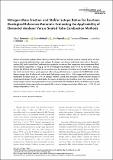Files in this item
Nitrogen mass fraction and stable isotope ratios for fourteen geological reference materials : evaluating the applicability of elemental analyser versus sealed tube combustion methods
Item metadata
| dc.contributor.author | Boocock, Toby | |
| dc.contributor.author | Mikhail, Sami | |
| dc.contributor.author | Prytulak, Julie | |
| dc.contributor.author | Di Ricco, Tommaso | |
| dc.contributor.author | Stueeken, Eva Elisabeth | |
| dc.date.accessioned | 2020-07-17T14:35:13Z | |
| dc.date.available | 2020-07-17T14:35:13Z | |
| dc.date.issued | 2020-09 | |
| dc.identifier | 268274961 | |
| dc.identifier | cdbbe25d-0315-4a4b-bf53-5127a89b26c5 | |
| dc.identifier | 000548865500001 | |
| dc.identifier | 85088040227 | |
| dc.identifier.citation | Boocock , T , Mikhail , S , Prytulak , J , Di Ricco , T & Stueeken , E E 2020 , ' Nitrogen mass fraction and stable isotope ratios for fourteen geological reference materials : evaluating the applicability of elemental analyser versus sealed tube combustion methods ' , Geostandards and Geoanalytical Research , vol. 44 , no. 3 , pp. 537-551 . https://doi.org/10.1111/ggr.12345 | en |
| dc.identifier.issn | 1751-908X | |
| dc.identifier.other | ORCID: /0000-0001-5276-0229/work/77525151 | |
| dc.identifier.other | ORCID: /0000-0001-6861-2490/work/77525166 | |
| dc.identifier.uri | https://hdl.handle.net/10023/20279 | |
| dc.description | Funding: Natural Environment Research Council (GrantNumber(s): NE/PO12167/1, NE/R012253/1) | en |
| dc.description.abstract | Thirteen commercially available silicate reference materials (RM) and one in‐house reference material, eleven of which have no previously published values, were analysed for nitrogen mass fraction and isotopic ratios with an Elemental Analyser (EA), and a Sealed Tube Combustion line, coupled to a continuous flow isotope ratio mass spectrometer (IRMS). These materials ranged from < 10 μg g−1 to 1% m /m nitrogen mass fractions and δ15N of −0.5 to +19.8‰. Existing nitrogen RM BHVO‐2, MS#5 and SGR‐1b were used to assess the accuracy of the data from the sealed tube combustion line, which was found to be in good agreement with existing published values. In contrast, the EA‐IRMS failed to fully liberate nitrogen from all silicate rocks and minerals (achieving a mean of 44 ± 10% nitrogen yield) resulting in kinetic fractionation of isotope values by −1.4‰ on average. Therefore, sealed tube combustion is better suited for analyses of silicate‐bound nitrogen. The EA worked reliably for organic samples, but care should be taken when using the EA for silicate nitrogen research. Moving forward, it is recommended that BHVO‐2, Biotite‐Fe, FK‐N and UB‐N be used as quality control materials as they appear to be most reproducible in terms of nitrogen mass fraction (relative error < 10%, 1s ), and isotopic composition (< 0.6‰, 1s ). | |
| dc.format.extent | 15 | |
| dc.format.extent | 1149914 | |
| dc.language.iso | eng | |
| dc.relation.ispartof | Geostandards and Geoanalytical Research | en |
| dc.subject | Nitrogen | en |
| dc.subject | Reference materials | en |
| dc.subject | Stable isotopes | en |
| dc.subject | Method validation | en |
| dc.subject | Geochemistry | en |
| dc.subject | QD Chemistry | en |
| dc.subject | QE Geology | en |
| dc.subject | DAS | en |
| dc.subject.lcc | QD | en |
| dc.subject.lcc | QE | en |
| dc.title | Nitrogen mass fraction and stable isotope ratios for fourteen geological reference materials : evaluating the applicability of elemental analyser versus sealed tube combustion methods | en |
| dc.type | Journal article | en |
| dc.contributor.sponsor | Carnegie Trust | en |
| dc.contributor.sponsor | NERC | en |
| dc.contributor.institution | University of St Andrews. School of Earth & Environmental Sciences | en |
| dc.contributor.institution | University of St Andrews. St Andrews Centre for Exoplanet Science | en |
| dc.contributor.institution | University of St Andrews. St Andrews Isotope Geochemistry | en |
| dc.identifier.doi | 10.1111/ggr.12345 | |
| dc.description.status | Peer reviewed | en |
| dc.identifier.grantnumber | RIG007794 | en |
| dc.identifier.grantnumber | NE/P012167/1 | en |
This item appears in the following Collection(s)
Items in the St Andrews Research Repository are protected by copyright, with all rights reserved, unless otherwise indicated.

